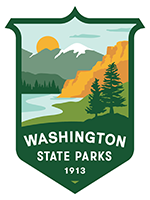Press Release
April 26, 2023
Dry Falls internationally recognized as scientifically significant geologic site
OLYMPIA – April 26, 2023 – Sun Lakes – Dry Falls State Park has long been known as a geological icon and must-see destination for Washingtonians. Now, its significant legacy is being recognized on an international scale.
The International Union of Geological Sciences (IUGS), one of the world's largest scientific organizations, has selected Dry Falls to be part of The First 100 IUGS Geological Heritage Sites, which includes areas designated by the geoscience community for their significant impact in understanding the Earth and its history.
"It is wonderful to see Dry Falls be recognized as one of the first 100 international geological heritage sites,” Parks Climate and Sustainability Coordinator, Ryan Karlson, said. “It is part of our mission to steward this special place so that future generations can experience this awesome remnant of our ice age past as we do today."
More than 200 specialists from almost 40 nations and 10 international organizations participated in the selection of the sites. There were 181 candidate sites from 56 countries proposed and evaluated by 33 international experts.
Other sites on The First 100 list include the Grand Canyon, Perito Moreno glacier in Argentina, Santorini Caldera in Greece and Uluru in Australia.
Dry Falls was previously designated by the Washington Geological Survey, part of the Washington Department of Natural Resources (DNR), as a “Washington 100” site. These sites highlight the 100 quintessential places to experience Washington's geology.
Formation of Dry Falls
Dry Falls, which is part of “the Great Cataract Group”, is a stunning example of the cataclysmic nature of the geologic processes that have shaped the Columbia Basin region of Washington. Though it has long dried out, it once held a waterfall that was five times the width and over two times the height of Niagara Falls. The dry 400-foot-high, 3.5-mile-wide remnants of this ice age waterfall make up one of the largest cataracts on the planet.
The area was first hypothesized to be formed by huge floods by scientist J. Harlan Bretz in 1923, though his theories were rejected for decades. Today, it is accepted that several massive ice age floods originated from the failure of an ice dam containing glacial Lake Missoula in present-day western Montana. En route to the Pacific Ocean, these floodwaters moved at highway speeds, reshaping large tracts of eastern and central Washington. Ice age floods created iconic and dynamic landscapes including Dry Falls, the Grand Coulee and the Columbia River Gorge.
Visiting Sun Lakes – Dry Falls
Visitors interested in checking out this geological wonder can visit the 3,774-acre Sun Lakes – Dry Falls State Park, which offers 73,640 feet of freshwater shoreline at the foot of Dry Falls between Soap Lake and Coulee City.
Start with a visit to the historic Vista House Overlook, which offers panoramic views of Dry Falls. The plunge pools surrounding the dormant waterfall are now home to a series of tranquil groundwater-fed lakes, an oasis for wildlife. Explore some of the recreation opportunities the park has to offer, including hiking more than 15 miles of trails, interpretive programs, camping, boating, paddling, swimming, golfing, miniature golfing, fishing and wildlife viewing.
Then stop and visit the Dry Falls Visitor Center, where indoor interpretive displays tell the story of the floods and their effects on Washington's landscape and the early human history of the region. The center also features a comprehensive bookstore — a must stop for those looking to learn more about the Ice Age floods story.
“It is an honor to help folks that stop at the Dry Falls Visitor Center truly understand the geologic grandeur and importance of Dry Falls,” said Sun Lakes – Dry Falls Interpretive Ranger David McWalter. “I love watching people's eyes look up, their mouths drop open, and then hearing them say: ‘Dry Falls and the Channeled Scablands are so much bigger than I thought!'”
Admission into the center is free, but donations are accepted. A Discover Pass is not required for parking at the Dry Falls Visitor Center. However, one is required within Sun Lakes – Dry Falls State Park. There is an automated pay station for visitors to purchase a one-day or annual Discover Pass and pay boat launch fees.
The park is also a notable site along the National Ice Age Floods Geologic Trail. The Ice Age Floods Institute regularly offers field trips, hikes and presentations, providing opportunities for members and the public to learn about the Ice Age Floods.
Other nearby attractions include Lake Lenore Caves State Park, located 10 miles south on State Route 17, and Steamboat Rock State Park, located 21 miles north on State Route 155.
Additional resources:
- Authorized DNR drone footage over Dry Falls – Sun Lakes State Park
- Nationally recognized geologist, Nick Zentner's, “Nick on the Rocks” PBS series episode featuring Dry Falls – Sun Lakes
- U.S. National Parks Service Ice Age Floods National Geologic Trail live webcam (Dry Falls Visitor's Center)
News media contacts:
Sarah Fronk, Communications Manager, media@parks.wa.gov
The Washington State Parks and Recreation Commission manages more than 100 state parks and properties totaling approximately 120,000 acres. The Commission provides a variety of recreation opportunities for citizens and provides stewardship protection for a diverse array of natural, cultural and historical resources. State Parks' statewide programs include long-distance trails, boating safety and winter recreation.
In the 1990s the International Union of Geological Sciences (IUGS) Global Geosites Working Group, with the support of ProGEO, IUCN and UNESCO, developed a database of geological sites of international relevance. A preliminary database was implemented in several European countries. In 2021, the IUGS International Commission on Geoheritage rejuvenated and reformulated this much-needed initiative in the context of the IGCP-731 project (International Geoscience Program). This project is now a collaborative effort involving UNESCO´s International Geosciences and Geoparks program, worldwide Geological surveys, research institutions as well as IUGS commissions and affiliated international organizations related to Earth Sciences.
